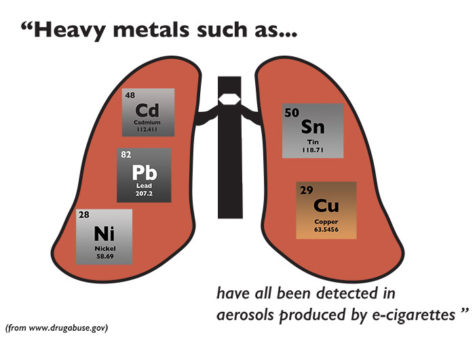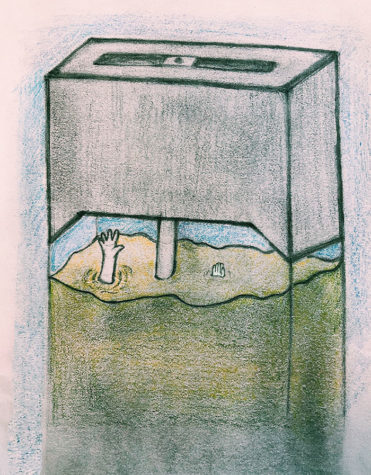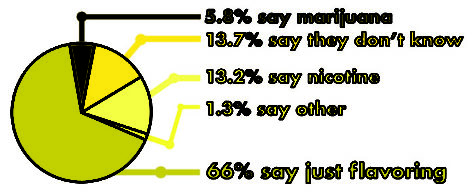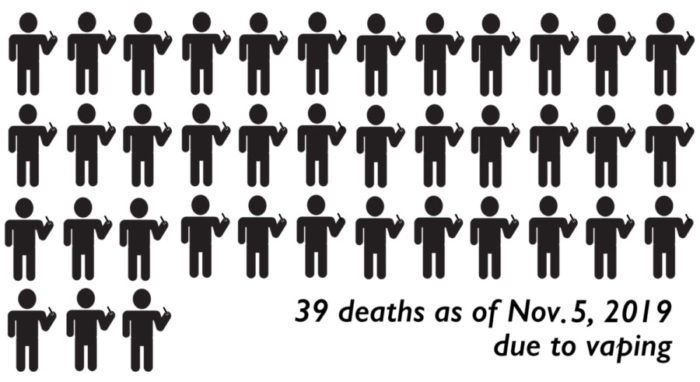DGS still buzzed by Juul epidemic
November 22, 2019
The presence of vaping at DGS has drawn attention from students, teachers and other staff. What used to be a social trend has evolved into something extremely different, and teenage vaping rates and injuries continue to rise. As of 2019, there have been 39 deaths linked to vaping, and for Illinois, 137 cases of illness. Teenage vaping is now considered to be an epidemic. With the rising rates of vaping at DGS, the numbers of illness, discipline and needs for resources have increased as well.
Consequences hit student vapers at DGS
A student walks into the PE locker room and carefully turns to face his locker while everyone is changing before class. He takes a concealed hit from his Juul before quickly passing it to his friend who continues the ritual. The supervising teacher walks past the aisle at the exact same time, instantly catching the students in the act.
The disciplinary policy for getting caught with vaping devices has many levels at DGS. On a first offense, a student receives social probation, which prohibits students from attending school-sponsored events and requires one day of in-school suspension. Along with a punishment from the school, they receive charges from the Downers Grove Police Department.
In accordance with Illinois law, one must be 21 years or older to purchase vaping materials, cigarettes and other tobacco products. Additionally, the use of recreational marijuana is currently illegal for all ages. This makes the consequences of being in possession of THC, a compound found in marijuana, more severe than those of nicotine.
Angela Earwood, Dean of Students, explained the differences in consequences for devices containing THC and devices containing nicotine.
“The police consequences of vaping [with a] nicotine product is a $75 fine. It could be for multiple devices, $75 for each one. For marijuana paraphernalia and devices, those tickets are $100. There is a difference in the school consequences as well because marijuana is an illegal drug,” Earwood said.

The policy for these drug-related problems has changed over the years as the number of products has increased.
The policy for these drug-related problems has changed over the years as the number of products has increased. The transition from cigarettes to vaping has increased teenage use of these products and effectively raised the school’s involvement in punishing these actions. Principal Ed Schwartz explained the adaptation of the school policy.
“I think the actual [severity of the] consequence has decreased. We are really trying to focus on how to help the kids, not just punish them, but try to help them learn new skills so they don’t keep making the same mistake,” Schwartz said.
Students who are on their first offense of possessing vaping devices are able to participate in an educational program to remove their social probation. This educational program provides students with information about the effects of vaping and is run by Student Assistance Coordinator Diana Benoist. Earwood explained how the program is run.
“When [the students] are in [in-school intervention], for part of the time they can do the [vaping educational] program. They have to read articles and answer questions, they have to watch videos, and then they are also required to have one follow up session with Mrs. Benoist. If they complete that, then [they] are off social probation,” Earwood said.
Vaping has been recognized as a prevalent problem at DGS. The number of students receiving punishments for vaping has increased by over 60% from the 2018 school year to the 2019 school year. Junior Devin Pope shared that he has witnessed many people facing the consequences of vaping.
“I’ve seen and heard a lot of kids getting caught at school. I feel like if you do vape and stuff like that at school, then there is a high chance of getting caught,” Pope said.
The staff continues to work to remove vaping from the school and promote a healthier, safer environment. Still, many students go unpunished for their use of these illegal products. Sophomore Hailey Lloyd shared that she believes the biggest flaw is the inability to identify all the students who vape during school.
“The school doesn’t catch a majority of the kids that vape, so many of the students go unpunished, but when the school does catch them, they receive good and fair punishments,” Lloyd said.
The presence of vaping at DGS has drawn attention from all aspects. Teenage vaping has been recognized as an epidemic, and the school has taken action to try and help students. Aside from disciplining students, the school works to inform on and prevent vaping.
“Each of the last three years, I have done parent nights where we have the parents come in, and we show them vape devices and talk to them so they can identify and work with their kids more. We do a lot of outreach and education around vaping. Aside from just punishment, we try to help kids make better choices, too,” Schwartz said.
Teen victims becoming ill due to nicotine addiction
As e-cigarette use continues to rise in Illinois, the consequences of vape addiction are becoming increasingly apparent among adolescents.
Illinois Department of Public Health (IDPH) representative Melaney Arnold detailed how choosing to vape is a dangerous decision, especially considering that professionals in the medical field have yet to discover the source of vape users’ lung injuries.
“At this time health officials have not identified the cause or causes of the lung injuries, and the only commonality among all cases is that patients report the use of vaping products, including e-cigarettes. No one compound or ingredient has emerged as the cause of these illnesses to date, and it may be that there is more than one cause of this outbreak,” Arnold said.
Arnold noted that the problems surrounding vaping only worsen with time, as the number and severity of lung injuries being reported to the IDPH increase each week.
“There are currently 137 reported cases, including one death and 33 individuals needing more investigation,” Arnold said.

Arnold indicated that these statistics are alarming because they are unlike anything health officials have previously identified.
Arnold indicated that these statistics are alarming because they are unlike anything health officials have previously identified.
“This is the first time we have seen an outbreak of lung injuries associated with vaping and e-cigarette use, so we do not have data to compare,” Arnold said.
2016 DGS alumnus Dylan Sheets was a regular consumer of e-cigarette products and recently experienced a severe health scare as a result of his vaping addiction. Sheets explained the main symptom he experienced before he was admitted to the hospital.
“My lungs started to feel tight, like every breath was only at 20% capacity,” Sheets said.
Sheets then recalled his week-long hospital stay. With proper medical assistance, he attempted to treat the long-lasting lung injuries he endured as a result of his vaping habits.
“I had to undergo a procedure to check my lungs with a camera that fired a spray to coat my lungs. I was in the hospital for about a week before being released as soon as my oxygen capacity was strong enough,” Sheets said.
Although Sheets was released from the hospital, his official diagnosis has yet to be identified, and it is unlikely he will fully heal from his injuries. In his daily life, he still experiences symptoms, sometimes needing to take pauses to catch his breath.
According to Arnold, Sheets’s situation is not an isolated incident.
“More than 100 people in Illinois have been hospitalized, the majority admitted to the ICU, after vaping. Some as young as 13 years,” Arnold said.
With this in mind, there is only one infallible solution to prevent vaping dangers: choosing not to vape altogether. Arnold shared her final warning for those who disregard this solution.
“People across the country have died [from abusing e-cigarette products]. Vaping as a teen can put your health at risk long-term and [IDPH] urges people to stop vaping,” Arnold said.
Staff works to break teen nicotine addiction: Levels of student vaping continue to escalate
In response to the vaping epidemic that is plaguing teens across the nation, DGS is offering numerous resources for students who are coping with a vaping addiction. The number one resource is Student Assistant Coordinator Diana Benoist.
Benoist is the go-to person for students who decide to seek help voluntarily as well as for those who get caught vaping at school. Conversations between her and students remain confidential, and they concentrate on the student’s place in his or her addiction.
“Oftentimes, it’ll come out that the student really has tried to quit … but is struggling to do that because nicotine is incredibly addictive, so sometimes I’ll start working with students that way, and we’ll start doing some goal-setting,” Benoist said. “I’ll try to check in regularly.”
Benoist uses a number of outside resources, including apps and community groups, that help students keep track of their progress. As of now, there are relatively few community resources available because vaping has only recently become commonplace.
“Because vaping is a relatively new phenomenon, there’s not a lot of community resources — they just haven’t been developed yet. There are a couple of counseling agencies in the area that are trying to work on developing more of a program for students who are trying to quit. … It’s a lot of conversation and goal-setting and working on reducing use. That’s the primary strategy,” Benoist said.
In addition students’ individual counselors also act as a first line of help for students with vaping addictions.
Students are referred to school nurse Gloria Barrera if they are experiencing health problems related to vaping. Barrera explained that there are a number of known health effects linked to vaping.
“It causes shortness of breath, headaches, vomiting, and in the worst cases, they can be sent to the hospital with a lung disease, and that’s, of course, thinking about long-term,” Barrera said.
If a student is referred to her, Barrera will perform a nursing assessment concentrated on the lungs. The results would then be documented and sent to that student’s dean.
Some students believe the school needs to do a more active job of advertising the help that it offers. Junior Raj Khullar doesn’t feel that many students who vape are aware of the school’s resources.

“Because vaping is a new phenomenon, many students don’t know the full implications of what they’re using.”
“I don’t think they do a good job of advertising what they have to help you get off of it if you’re on it. Instead, they just have a bunch of posters telling you not to do it. … On that ad they could put up what resources they have, instead of just an anti-Juul ad at the end, they could put up what resources they have to help you get off of it if you have an addiction,” Khullar said.
Barrera believes that students need to be better educated. Because vaping is a new phenomenon, many students don’t know the full implications of what they’re using.
“Maybe students really don’t understand that there are these chemicals, and metals and artificial flavorings that can cause everything that I mentioned already. Just not being aware … if you were aware, you probably wouldn’t be doing it. There’s not enough education out there,” Barrera said.

